Evaluation of the Functional Status of the Posture Control System in Children with Detected Disorders in Body Posture
Abstract
1. Introduction
2. Materials and Methods
2.1. Subjects
- Disturbed alignment of the spine in the frontal plane;
- Disturbed alignment of the spine in the sagittal plane;
- Scoliosis (positive result in the Adam’s test);
- Knee malalignment (valgus or varus);
- Foot malalignment (valgus, varus or flatfoot).
- -
- physical disability;
- -
- mental disability;
- -
- developmental anomalies of the feet;
- -
- true shortening of a lower limb;
- -
- sensory integration disorders;
- -
- neurological conditions;
- -
- nystagmus;
- -
- attention deficit disorder;
- -
- feeling unwell on the day of the examination.
2.2. Procedures
2.2.1. Instruments
2.2.2. Algorithms
2.2.3. Indicator of Proprioceptive Control
2.2.4. Single Stance Stability Assessment
2.3. Statistical Analysis
3. Results
4. Discussion
5. Conclusions
- Proprioceptive control significantly increases with age in children with diagnosed postural defects.
- Girls aged 8 to 10 years had statistically significantly better results in proprioceptive control compared to boys, in all age groups.
- The number of postural defects does not significantly impair posture stability in any of the age groups from 8 to 10 years.
- The number of postural defects has no significant effect on proprioceptive control.
Author Contributions
Funding
Institutional Review Board Statement
Informed Consent Statement
Data Availability Statement
Conflicts of Interest
References
- Zeyland-Malawka, E. Posturogenesis in ontogenesis: Controversies. In The Human is the Measure of All Things/Red; Jerzemowski, J., Grzybiak, M., Piontek, J., Eds.; Tower Press: Sopot, Poland, 2006. [Google Scholar]
- Riva, D.; Trevisson, P.; Minoletti, R.; Riccio, M.C. Sports influence on dynamic postural control during human growth. In Human Growth from Conception to Maturity. Auxology Advances in the Study of Human Growth and Development; Benso, L., Gilli, G., Schell, L.M., Eds.; Smith-Gordon: London, UK, 2002; Volume 4, pp. 325–332. [Google Scholar]
- Riva, D.; Mamo, C.; Fanì, M.; Saccavino, P.; Rocca, F.; Momenté, M.; Fratta, M. Single Stance Stability and Proprioceptive Control in Older Adults Living at Home: Gender and Age Differences. J. Aging Res. 2013, 2013, 561695. [Google Scholar] [CrossRef]
- Schiavi, A.; Germak, A.; Mazzoleni, F.; Riva, D. Metrological Characterization of Rocking Boards and Postural Readers to Assess Single Stance Stability in Human Subjects. In Proceedings of the 3rd Conference on Vibration Measurement, Cape Town, South Africa, 3–5 February 2014. [Google Scholar]
- Riva, D.; Soardo, P. Refinding equilibrium. Sport Med. 1999, 5, 55–58. [Google Scholar]
- Riva, D. Archaeoproproception: What is it and how can we train it. Sport Med. 2000, 49–55. [Google Scholar]
- Kowal, R. Badania częstości występowania wad postawy ciała i ich związek z budową somatyczną i rozwojem fizycznym dzieci i młodzieży w wieku od 9 do 16 lat w Radomiu. Doctoral Thesis, Uniwersytet Mikołaja Kopernika w Toruniu, Bydgoszcz, Poland, 2014. [Google Scholar]
- Pokrywka, J.; Fugiel, J.; Posłuszny, P. Częstość wad postawy ciała u dzieci z Zagłębia Miedziowego. Fizjoterapia 2011, 19, 3–10. [Google Scholar]
- Kaczmarek, J.; Raczkowski, J.; Krajewski, T. Analiza częstości występowania wad postawy u dzieci i młodzieży wybranej dzielnicy aglomeracji łódzkiej. Kwart. Ortopedyczny. 2001, 1. [Google Scholar]
- Latos-Bieleńska, A.; Materna-Kiryluk, A.; PRCM Working Group. Polish Registry of Congenital Malformations—Aims and organization of the registry monitoring 300,000 births a year. J. Appl. Genet. 2005, 46, 341–348. [Google Scholar] [PubMed]
- Latos-Bieleńska, A.; Materna-Kiryluk, A. Polski Rejestr Wrodzonych Wad Rozwojowych; OWN: Poznań, Poland, 1998. [Google Scholar]
- Latos-Bieleńska, A.; Materna-Kiryluk, A.; Mejnartowicz, J.P. Wrodzone wady rozwojowe w Polsce w latach 1998–1999: Dane z Polskiego Rejestru Wrodzonych Wad Rozwojowych; OWN: Poznań, Poland, 2006. [Google Scholar]
- Latos-Bieleńska, A.; Materna-Kiryluk, A. Wrodzone Wady Rozwojowe w Polsce w Latach 2000–2002; OWN: Poznań, Poland, 2002. [Google Scholar]
- Maciałczyk-Paprocka, K.; Krzyżaniak, A.; Kotwicki, T.; Kałużny, Ł.; Przybylski, J. Postawaciała u dzieci w wiekuprzedszkolnym. Probl. Hig. Epidemiol. 2011, 92, 286–290. [Google Scholar]
- Maciałczyk-Paprocka, K. Epidemiologia wad Postawy u Dzieci i młodzieży. Doctoral Thesis, Uniwersytet Medyczny im. Karola Marcinkowskiego w Poznaniu, Poznań, Poland, 2013. [Google Scholar]
- Mazur, J.; Małkowska-Szkutnik, A. (Eds.) Aktywność fizyczna i zajęcia w czasie wolnym. In Wyniki badań HSBC 2010; Raport Techniczny; Instytut Matki i Dziecka: Warszawa, Poland, 2011; pp. 109–121. [Google Scholar]
- Sakowska, I.; Wojtyniak, B. Wybrane czynniki ryzyka zdrowotnego związane ze stylem życia. In Sytuacja zdrowotna ludności Polski; Wojtyniak, B., Goryński, P., Eds.; Narodowy Instytut Zdrowia Publicznego—Państwowy Zakład Higieny: Warszawa, Poland, 2008; pp. 185–199. [Google Scholar]
- Pawlicka-Lisowska, A.; Gątkiewicz, M.; Motylewski, S.; Górecka, U.; Poziomska-Piątkowska, E. Postawaciała a wskaźniki antropometryczne. Kwart. Ortopedyczny. 2011, 1, 50–56. [Google Scholar]
- Wojna, D.; Anwajler, J.; Hawrylak, A.; Barczyk, K. Assessment of body posture in younger schoolchildren. Physiotherapy. 2010, 18, 27–39. [Google Scholar] [CrossRef]
- Kasperczyk, T. Wady Postawy Ciała: Diagnostyka i Leczenie; Firma Usługowo-Handlowa “Kasper”: Kraków, Poland, 1994; pp. 9–37. [Google Scholar]
- Górecka, U.; Zientala, A.; Pawlicka-Lisowska, A.; Jerzakowski, G.; Poziomska-Piątkowska, E. Porównanie sprawności fizycznej dzieci z postawą skoliotyczną i ich rówieśników w wieku 11–12 lat. Kwart. Ortopedyczny 2012, 3, 425–431. [Google Scholar]
- Kostiukow, A.; Rostkowska, E.; Samborski, W. Badanie zdolności zachowania równowagi ciała. Ann. Acad. Med. Stetin. 2009, 55, 102–109. [Google Scholar] [PubMed]
- Brzęk, A.; Nowotny-Czupryna, O.; Famula, A.; Kowalczyk, A. Postrzeganie przebiegu pionu i poziomu u dzieci z nieprawidłową postawą ciała. Fizjoterapia Pol. 2008, 8, 445–453. [Google Scholar]
- Ostałowska, B.; Rożek-Piechura, K.; Skolimowski, T. Odzyskiwanie dynamicznej równowagi po zewnętrznych zaburzeniach postawy u dzieci z idiopatyczną skoliozą. Ortop. Traumatol. Rehabil. 2006, 8, 303–307. [Google Scholar]
- Simoneau, M.; Lamonthe, V.; Hutin, E.; Mercier, P. Evidence for cognitive vestibular integration in idiopathic scoliosis patients. BMC Neurosci. 2009, 10, 102–107. [Google Scholar] [CrossRef]
- Herdea, A.; Dragomirescu, M.; Ulici, A.; Lungu, C.; Charkaoui, A. Controlling the Progression of Curvature in Children and Adolescent Idiopathic Scoliosis Following the Administration of Melatonin, Calcium, and Vitamin D. Children 2022, 9, 758. [Google Scholar] [CrossRef]
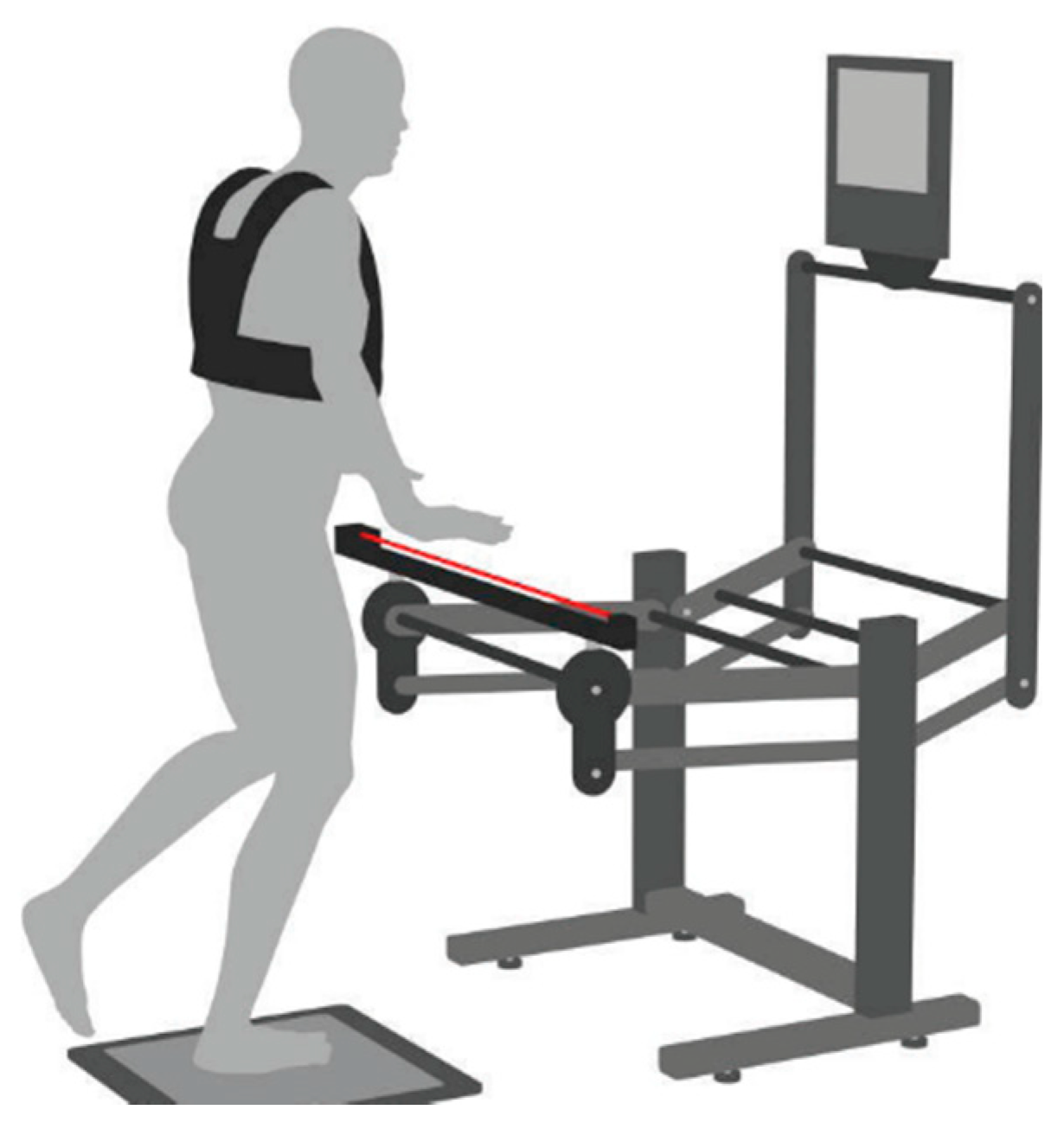
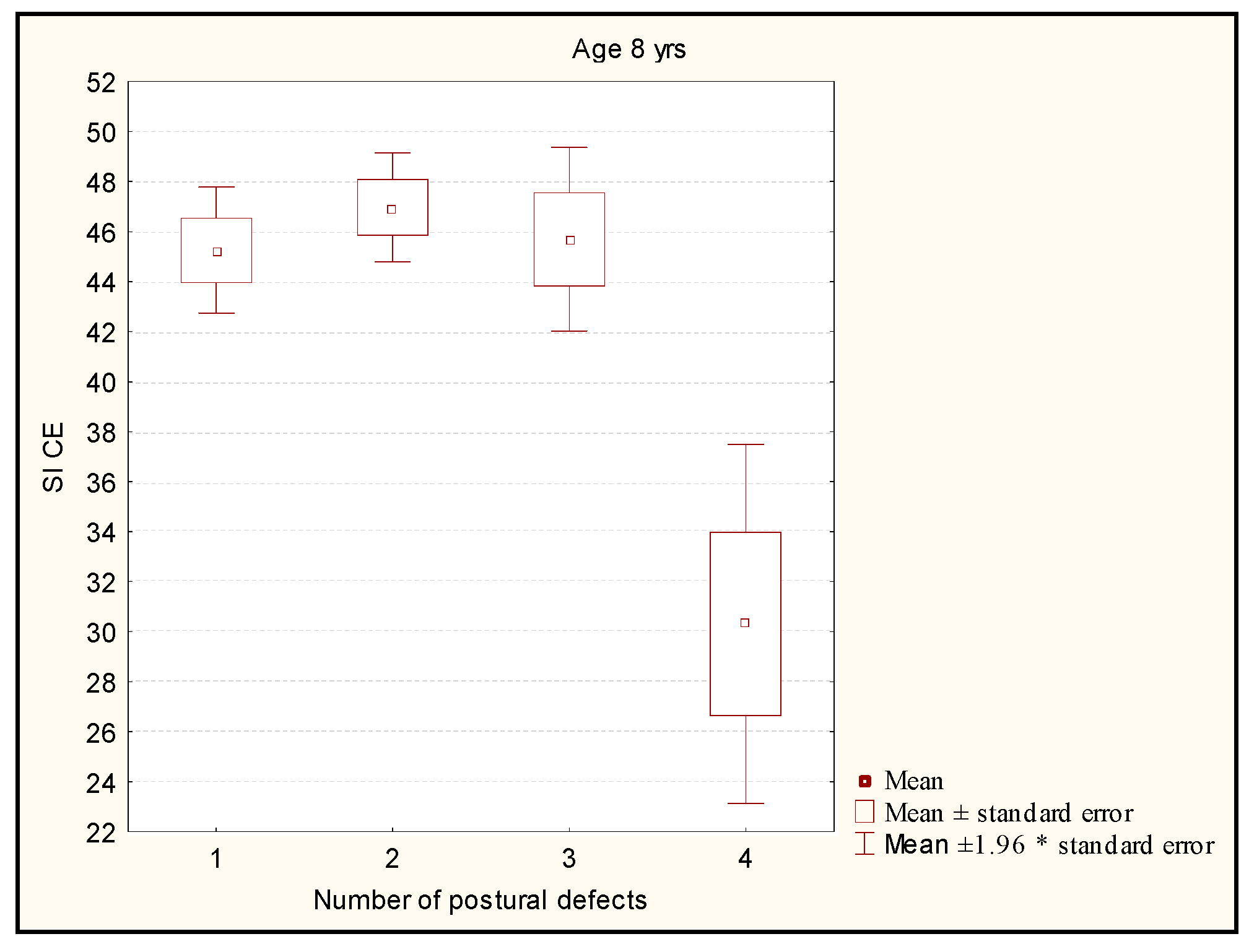
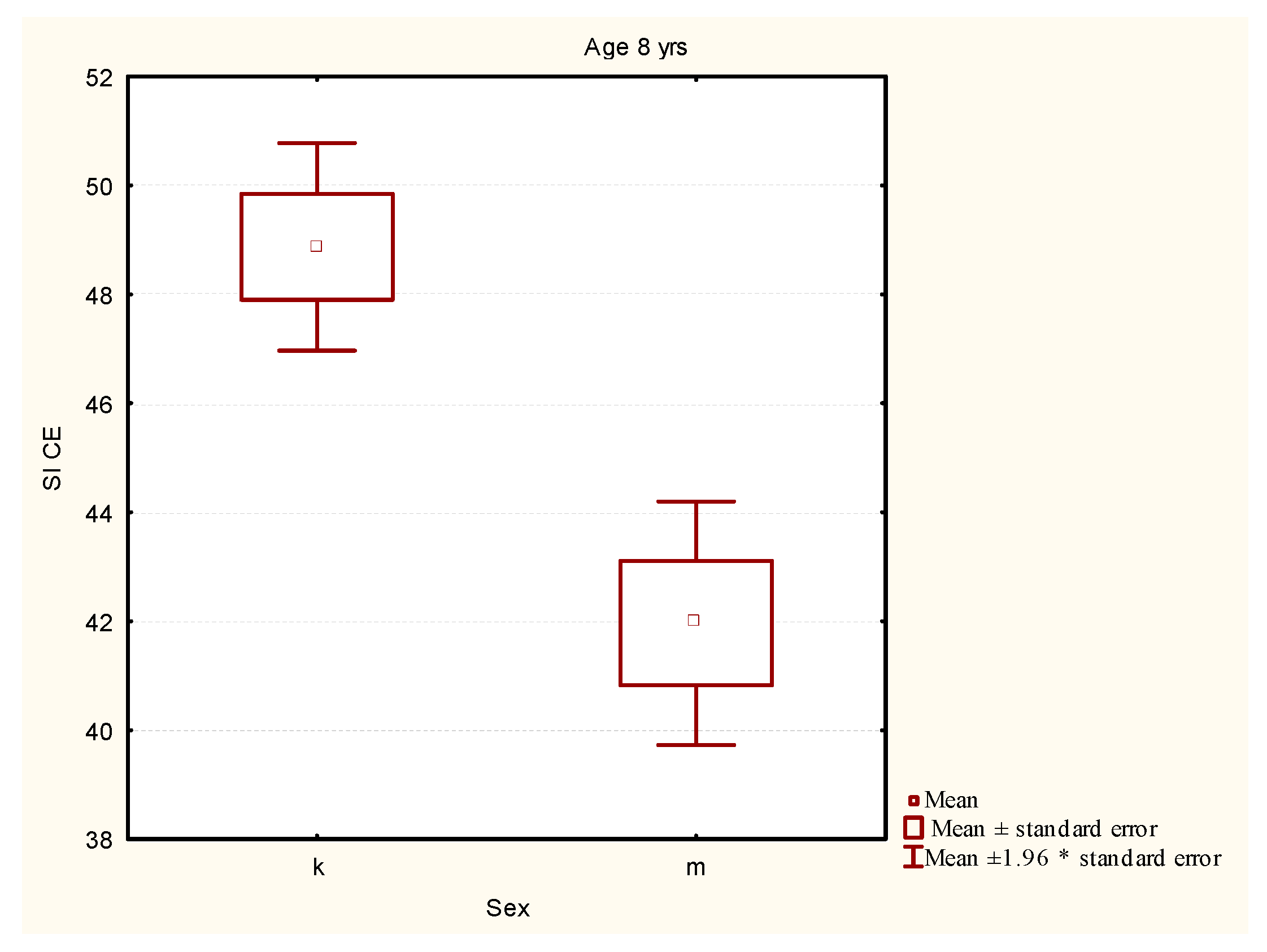

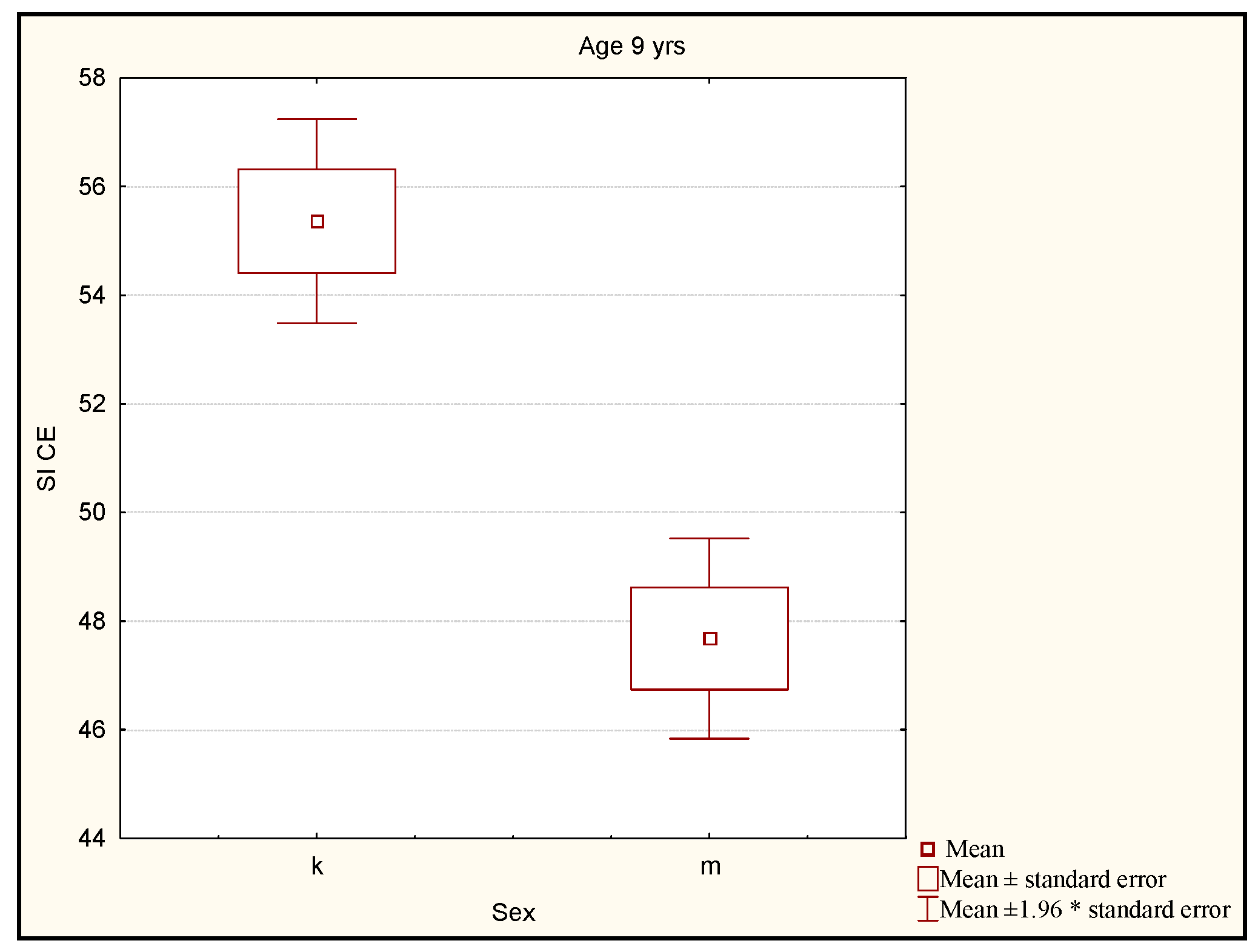
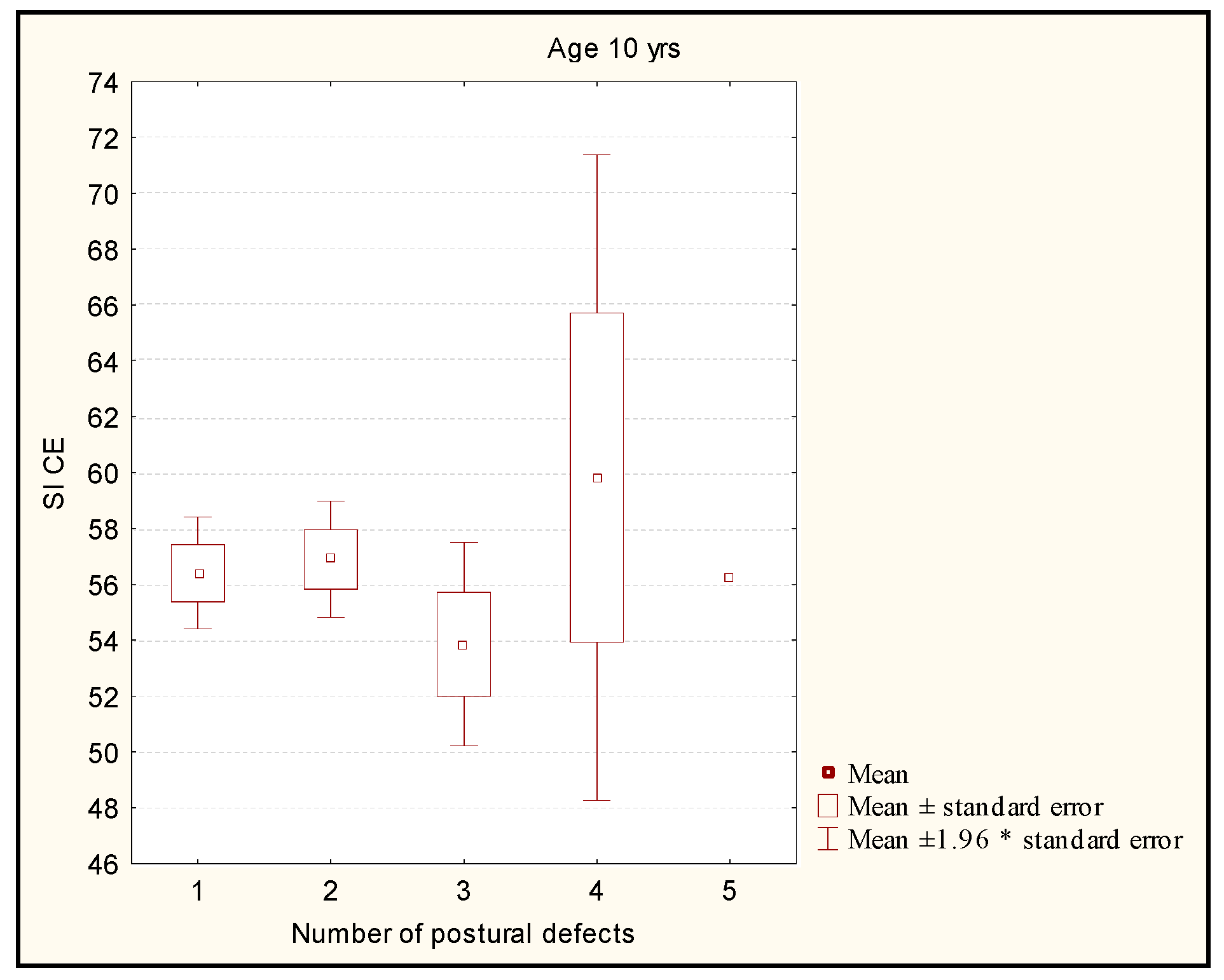

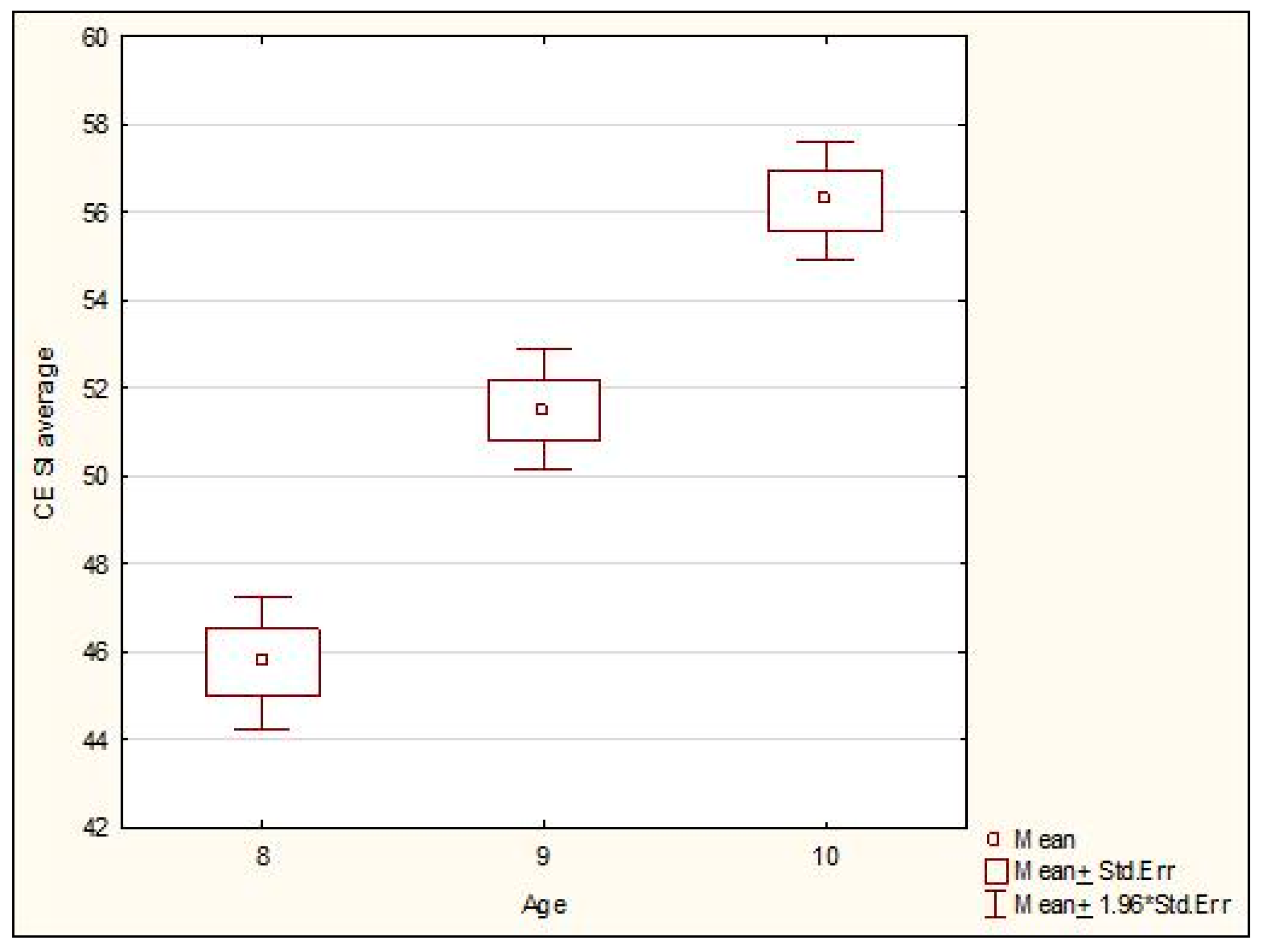
| Age of the Subjects | G + B | G | B | |||
|---|---|---|---|---|---|---|
| N | % * | n | % ** | N | % *** | |
| 8 yrs | 333 | 30.6 | 183 | 32.5 | 150 | 28.5 |
| 9 yrs | 393 | 36 | 196 | 34.7 | 197 | 37.5 |
| 10 yrs | 364 | 33.4 | 185 | 32.8 | 179 | 34 |
| Total | 1090 | 100 | 564 | 100 | 526 | 100 |
| Age 8 yrs | |||
|---|---|---|---|
| SI CE | |||
| Number of Disorders | N | Mean | SD |
| 1 disorder | 122 | 45.25 | 14.21 |
| 2 disorders | 144 | 46.96 | 13.28 |
| 3 disorders | 60 | 45.69 | 14.47 |
| 4 disorders | 7 | 30.31 | 9.69 |
| 5 disorders | no cases identified | ||
| Age 9 yrs | |||
|---|---|---|---|
| SI CE | |||
| Number of Disorders | N | Mean | SD |
| 1 disorder | 117 | 52.97 | 13.51 |
| 2 disorders | 196 | 51.43 | 13.64 |
| 3 disorders | 73 | 49.14 | 14.97 |
| 4 disorders | 6 | 55.85 | 9.55 |
| 5 disorders | 1 | 42.52 | 0 |
| Age 10 yrs | |||
|---|---|---|---|
| SI CE | |||
| Number of Disorders | N | Mean | SD |
| 1 disorder | 140 | 23.03 | 9.66 |
| 2 disorders | 154 | 23.18 | 11.33 |
| 3 disorders | 61 | 25.06 | 10.16 |
| 4 disorders | 8 | 21.40 | 17.69 |
| 5 disorders | 1 | 24.07 | 0 |
| SI CE | |||
|---|---|---|---|
| Age | N | Mean | SD |
| 8 yrs | 333 | 45.76 | 13.94 |
| 9 yrs | 393 | 51.51 | 13.82 |
| 10 yrs | 364 | 56.25 | 13.06 |
Publisher’s Note: MDPI stays neutral with regard to jurisdictional claims in published maps and institutional affiliations. |
© 2022 by the authors. Licensee MDPI, Basel, Switzerland. This article is an open access article distributed under the terms and conditions of the Creative Commons Attribution (CC BY) license (https://creativecommons.org/licenses/by/4.0/).
Share and Cite
Permoda-Białozorczyk, A.; Olszewska-Karaban, M.; Permoda, A.; Zajt, J.; Wiecheć, M.; Żurawski, A. Evaluation of the Functional Status of the Posture Control System in Children with Detected Disorders in Body Posture. Int. J. Environ. Res. Public Health 2022, 19, 14529. https://doi.org/10.3390/ijerph192114529
Permoda-Białozorczyk A, Olszewska-Karaban M, Permoda A, Zajt J, Wiecheć M, Żurawski A. Evaluation of the Functional Status of the Posture Control System in Children with Detected Disorders in Body Posture. International Journal of Environmental Research and Public Health. 2022; 19(21):14529. https://doi.org/10.3390/ijerph192114529
Chicago/Turabian StylePermoda-Białozorczyk, Anna, Marzena Olszewska-Karaban, Andrzej Permoda, Jolanta Zajt, Marek Wiecheć, and Arkadiusz Żurawski. 2022. "Evaluation of the Functional Status of the Posture Control System in Children with Detected Disorders in Body Posture" International Journal of Environmental Research and Public Health 19, no. 21: 14529. https://doi.org/10.3390/ijerph192114529
APA StylePermoda-Białozorczyk, A., Olszewska-Karaban, M., Permoda, A., Zajt, J., Wiecheć, M., & Żurawski, A. (2022). Evaluation of the Functional Status of the Posture Control System in Children with Detected Disorders in Body Posture. International Journal of Environmental Research and Public Health, 19(21), 14529. https://doi.org/10.3390/ijerph192114529







